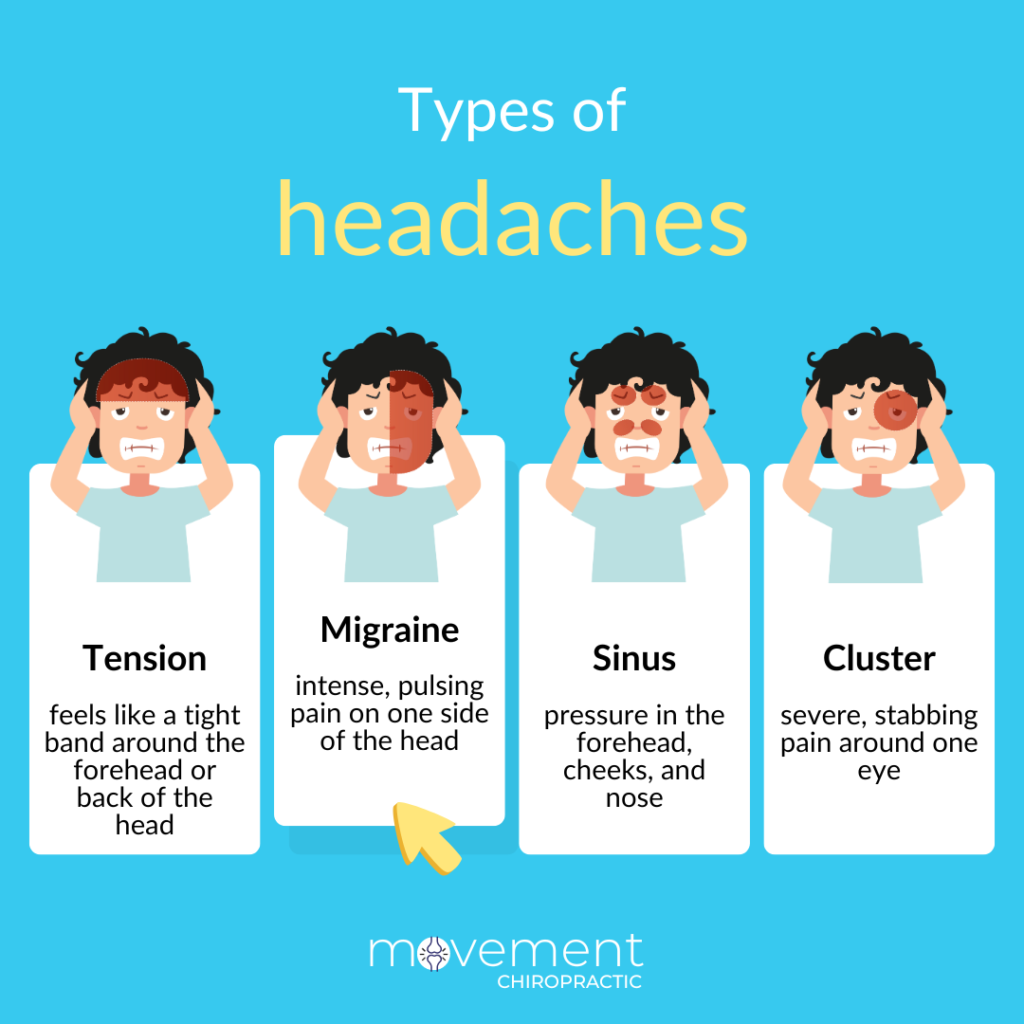Headaches and migraines affect millions, causing discomfort and disruptions in daily life. While medications may provide temporary relief, chiropractic care offers a natural, drug-free solution that addresses the root cause of headaches for long-lasting results.

Common Types of Headaches
Here are the most common types of headaches:
-
Tension HeadachesTension headaches feel like a tight, band-like pressure around the forehead or back of the head, often triggered by stress, muscle tension, or poor posture, and can last from hours to days.
-
MigrainesMigraines are intense, throbbing headaches on one side of the head, accompanied by nausea, sensitivity to light and sound, and sometimes visual aura, triggered by hormonal changes or specific foods.
-
SinusSinus headaches are caused by sinus inflammation, leading to pain in the forehead, cheeks, or nose, often with congestion and facial pressure.
-
Cluster HeadachesCluster headaches cause severe, stabbing pain around one eye, occurring in cycles, often with nasal congestion or watery eyes.
Cervicogenic Headaches: A Modern-Day Problem
Cervicogenic headaches are becoming more common in today’s world, often due to poor posture and prolonged use of electronic devices—a condition known as “tech neck.” These headaches originate from the neck (cervical spine) and can be caused by:
- Overuse of electronic devices: Looking down at phones, tablets, or computers for extended periods strains the neck.
- Sedentary lifestyle: Long hours of sitting with poor posture lead to neck tension and muscle imbalances.
Cervicogenic headaches typically start at the base of the skull and radiate to the forehead, temples, or behind the eyes. The pain is often aggravated by neck movement and won’t improve with over-the-counter medications. This is where chiropractic care becomes essential.

How Chiropractic Care Helps
Chiropractic care offers a holistic approach to headache relief by addressing the root causes, rather than just managing symptoms. Here’s a glimpse of how chiropractic treatments can help:
Misalignments in the neck can lead to headaches by irritating nerves. Chiropractic adjustments realign the spine, relieving nerve pressure and reducing pain. Poor neck movement and tight muscles in the neck and shoulders often make headaches worse. Chiropractic care improves mobility and loosens tense muscles, giving you fast, effective relief.
Prolonged device use and poor posture strain neck muscles, contributing to headaches. Chiropractors help correct posture, provide ergonomic advice, and recommend exercises to reduce muscle strain.
Chiropractic adjustments can improve drainage in the sinuses, helping to relieve sinus congestion and reduce the pressure that causes sinus headaches.
Why Chiropractic Care?
- Drug-Free Relief
- Addressing the Root Cause
- Personalized Treatment
If you’re experiencing tension, cervicogenic, sinus headaches, or migraines, chiropractic care offers a safe, natural alternative to medication. By addressing spinal misalignments, muscle tension, and lifestyle factors, chiropractors can help reduce the frequency and intensity of headaches, providing lasting relief.
For more information on how chiropractic care can help with neck pain, Explore our detailed guide here.
Book your consultation at Movement Chiropractic today and discover how chiropractic care can help you find natural, drug-free relief from headaches and migraines.
References:
- Headache Society. (2023). Types of Headaches: Causes, Symptoms, and Relief. Retrieved from American Headache Society.
- Mayoclinic. (2022). Headaches: Causes and Treatment. Retrieved from Mayo Clinic.
- Spine-health. (2023). What is Cervicogenic Headache?. Retrieved from Spine-health.





